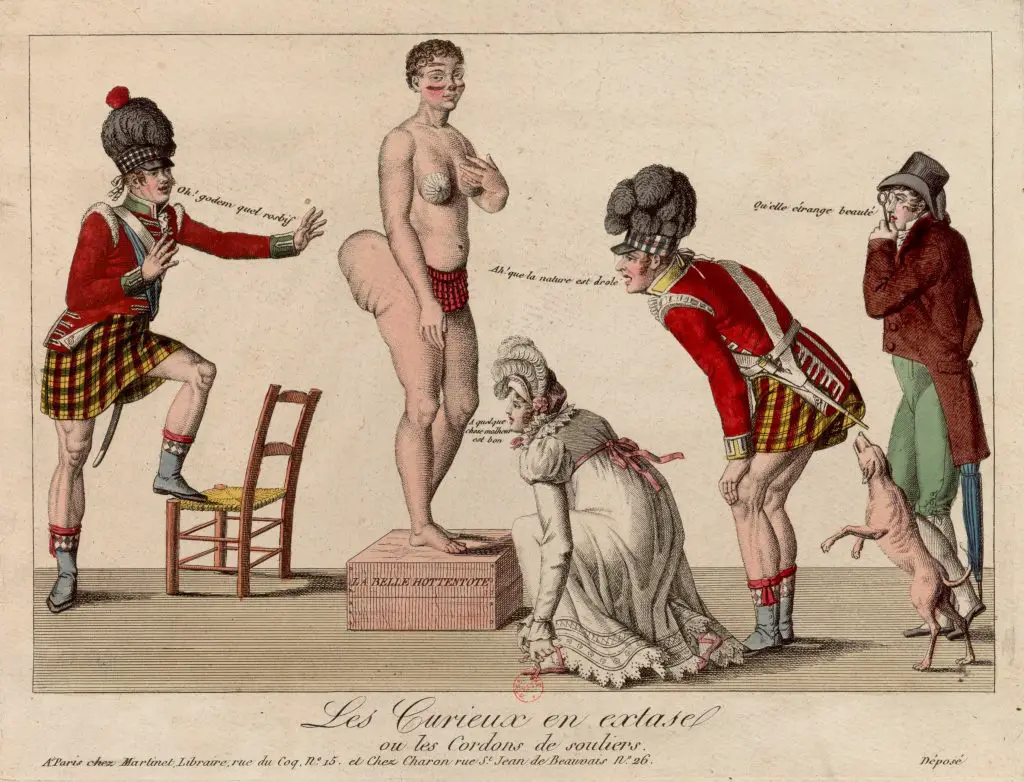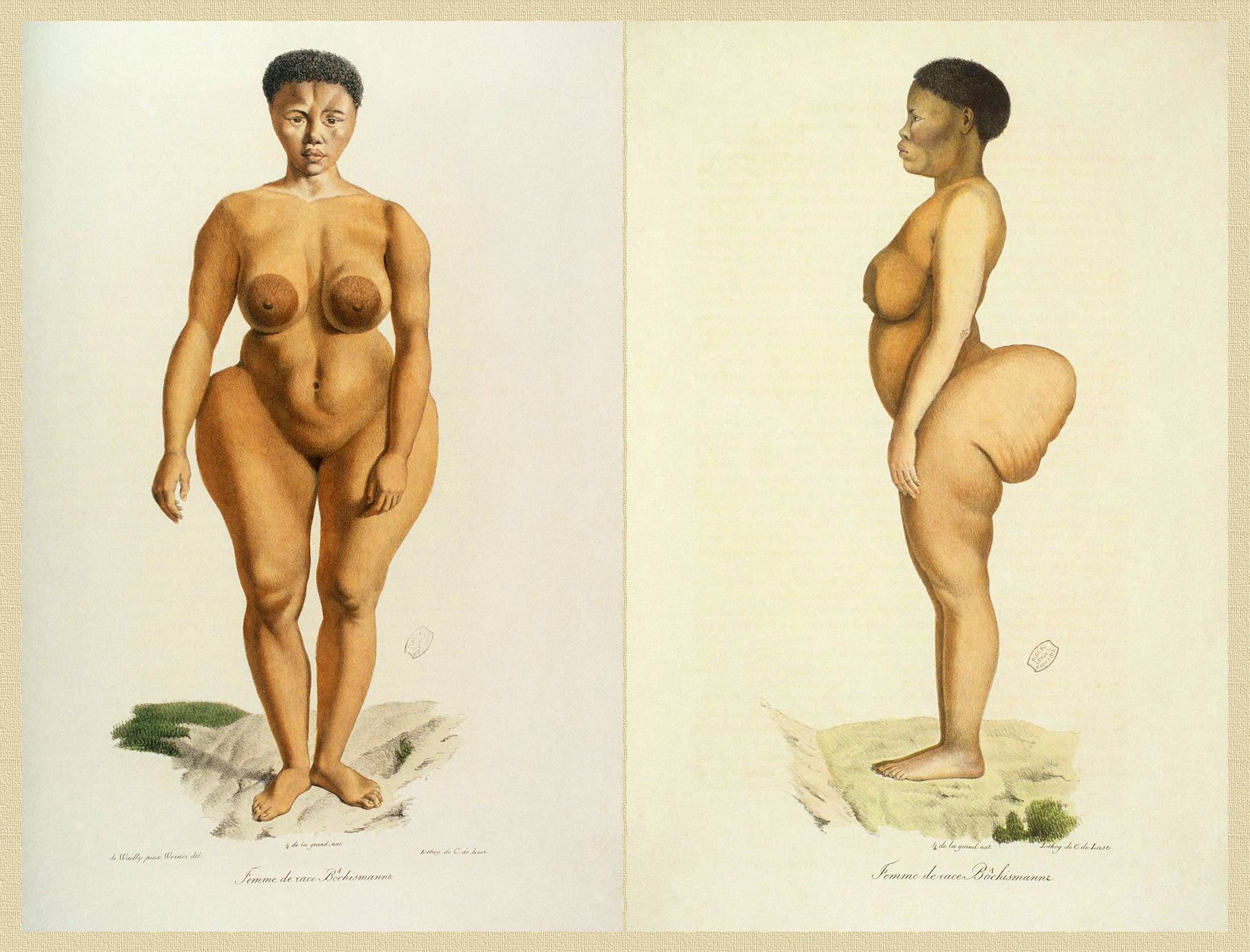 bjectification and over-sexualization of black women have become the standard in today’s environment. Black women’s bodies are continuously exhibited for amusement in everything from rap videos to movies. Sex sells, and it sells even more when black bodies are on display. The over-sexualization of black women can be traced back to the 1800s when Sarah Baartman’s (born Saartjie Bartman) buttocks were exhibited across Europe to entertain Caucasian Europeans.
bjectification and over-sexualization of black women have become the standard in today’s environment. Black women’s bodies are continuously exhibited for amusement in everything from rap videos to movies. Sex sells, and it sells even more when black bodies are on display. The over-sexualization of black women can be traced back to the 1800s when Sarah Baartman’s (born Saartjie Bartman) buttocks were exhibited across Europe to entertain Caucasian Europeans.
The Origin of Sarah Baartman
Sarah was born in 1787 to Khoisan parents and was given the name “Ssehura” at birth. Sarah married a musician from her tribe when she was a teenager. Sarah’s husband was slain after a disagreement with Dutch colonists, and she was sold as a slave to Pieter Willem, who transported her to his Cape Town home to work as a servant. He changed her name to “Saartjie” later on.
Sarah signed a contract with Pieter’s acquaintance in 1810, agreeing to work as a house servant for him in London and to be used for amusement on occasion. It is unclear if she did so voluntarily or was compelled to.
Sarah moved to London, lured by the prospect of a better life and more money. She had no idea what was in store for her.
Sarah’s low literacy level did not assist because it made it difficult for her to comprehend the genuine intentions of those around her. She quickly became that African woman with a huge posterior on a freak show. As time passed, awareness spread, and Sarah began to play at other exhibitions across the world.
Exploitation
Sarah was displayed in human zoos alongside animals in Britain, Ireland, Belgium, and Paris from 1810 to 1815. During the shows, she was either scantily dressed or naked, and she paraded around public places with animals. She was also taken to wealthy clients’ houses to entertain them.
Sarah was transferred from England to France in 1814 and sold to Reaux, a guy who displayed animals. He toured Paris with her and profited handsomely from the French fascination with Sarah’s body. Sarah was shown in a cage alongside baby rhinos, according to Reaux. Her condition deteriorated as she was treated like an animal and forced to do stunts as if she were a circus animal.
Sarah was not only utilized as a source of humor at these exotic Europe events, but she was continually mocked, poked, ridiculed, and sexualized. Sarah was inspected by a commission of zoologists and psychiatrists in March 1815. A painting of her naked was also created.

A group of British abolitionists who were lobbying against slavery observed Sarah’s presence at exhibitions. They also saw that she had been forced to act under coercion and enslavement.
The abolitionists made it a point to assist Sarah. They filed a lawsuit against the group that indecently utilized her on stage, seeking restitution for wrongful treatment.
The legal effort to rescue Sarah from her exhibitors ended in failure. Unfortunately, once a signed contract between Sarah and Dunlop was tendered, the court ruled in favor of the exhibition organization.
Sarah’s health rapidly worsened after being on display at exhibitions for so long. She died in 1815, at the age of 27, in Paris, France. It is thought that she died of TB or syphilis.
George Cuvier, a distinguished French scientist, was granted permission to dissect her body within hours of her death. He concentrated on her brain, buttocks, and private regions while doing so. Sarah’s remains were placed on exhibit at the Paris museum for a long period. It was treated with special coatings to keep it from degrading. It was eventually removed and stored in 1974.
Nothing was heard about her ordeals after her death until the 1990s, when former South African President Nelson Mandela and other campaigners advocated for her return to South Africa.
It was difficult to return Sarah’s remains to her home country of South Africa. However, following a dialogue between the French and South African governments, the French National Assembly voted unanimously to repatriate her body to South Africa. This was completed in 2002.
Sarah’s body was later returned to Gamtoos Valley and properly buried in Hankey, Eastern Cape, South Africa.
Avid Writer with invaluable knowledge of Humanity!
Upcoming historian with over 30 million views online.
“You make your own life.”





